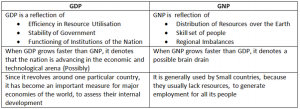
Table of Contents
What is GDP?
- GDP stands for Gross Domestic Product and measures the monetary value of all imports and services produced inside nations geographic borders during a specific period.
What is GNP?
- GNP stands for Gross National Product and measures the monetary value of output and services produced by all citizens of a country both domestically and abroad. However, it does not include the output of foreign residents.
- GNP = GDP + net property income from abroad
What is GNI?
- GNI (Gross National Income) is based on a similar principle to GNP.
The World Bank defines GNI as:
“GNI is the sum of value added by all resident producers plus any product taxes (minus subsidies) not included in the valuation of output plus net receipts of primary income (compensation of employees and property income) from abroad.” (World Bank)
- The World Bank now use GNI rather than GNP.
13 differences between GDP and GNP with examples:
| Differences based on | Gross Domestic Product | Gross National Product |
| Definition | Gross domestic product is the value of a country’s finished domestic goods and services i.e. the value of work done by employees, companies and self-employed persons during a specific time.
|
Gross National product is another metric used to measure a country’s economic output. GNP is the market value of goods and services produced by all citizens of a country both domestically and abroad |
| Meaning | The worth of goods and services produced within the geographical limits of the county is known as Gross Domestic Product (GDP). | The worth of goods and services produced by the county’s citizens irrespective of the geographical location is known as Gross National Product (GNP). |
| Indicator | Gross domestic product is the most basic indicator used to measure the overall health and size of the country’s economy. | Gross National Product represents how the citizens are subsidizing to the country’s economy. |
| Mainly used | To study outlines of domestic economy | To study of find out how residents are contributing to the economy |
| What is it? | Production of products within the country’s borderline. | Production of products by the enterprises retained by the residents of the country. |
| Basis | Location | Citizenship |
| Measurement | It is a measurement of domestic production | It is a measurement of production by nationals |
| What is included? | Goods and services produced by foreigners within that country | Goods and services produced by citizens living outside the country |
| What is excluded? | Goods and services produced by citizens outside the country | Goods and services produced by foreigners within that country |
| Scale on which productivity is measured | On a local level/scale | On an international scale/scale |
| Examples | If a Japanese multinational produces cars in the UK, this production will be counted towards UK GDP. However, if the Japanese firm sends £50m in profits back to shareholders in Japan, then this outflow of profit is subtracted from GNP. UK nationals do not benefit from this profit, which is sent back to Japan.
If a UK firm makes a profit from insurance companies located abroad, then if this profit is returned to UK nationals, then this net income from overseas assets will be added to UK GNP. Note, if a Japanese firm invests in the UK, it will still lead to higher GNP, as some national workers will see higher wages. However, the increase in GNP will not be as high as GDP. · If a county has similar inflows and outflows of income from assets, then GNP and GDP will be very similar. · However, if a country has many multinationals who repatriate (send back to the own country) income from local production, then GNP will be lower than GDP. For example, Luxembourg has a GDP of $87,400 but a GNP of only $45,360. A country like Ireland has received significant foreign investment. Therefore, for Ireland, there is a net outflow of income from the profits of these multinationals. Therefore, Irish GNP is lower than GDP. A German investor, who transfers the dividend income generated from her shareholdings to Germany, will both be excluded from GNP. On the other hand, if a U.S.-based news reporter is sent to South Korea and sends her Korean earnings home, or a U.S.-based airline generates income from its overseas operations, they both contribute positively to the country’s GNP. |
|
| Summaries | The strength of the country’s domestic economy. | How the residents are contributing to the country’s economy. |
| Productivity scale | Productivity is measured on a local scale. | Productivity is measured on an international scale. |
| Calculation | Calculating GDP includes adding together private consumption or consumer spending, government spending, and capital spending by businesses, and net exports.
Here’s a brief overview of each component: Consumption: The value of the consumption of goods and services acquired and consumed by the country’s households. This accounts for the largest part of GDP Government Spending: All consumption, investment, and payments made by the government for current use Capital Spending by Businesses: Spending on purchases of fixed assets and unsold stock by private businesses Net Exports: Represents the country’s balance of trade (BOT), where a positive number bumps up the GDP as country exports more than it imports, and vice versa GDP = Consumption+ Investment + Government Spending + Net export.
|
GNP can be calculated by adding consumption, government spending, capital spending by businesses, and net exports (exports minus imports) and net income by domestic residents and businesses from overseas investments. This figure is then subtracted from the net income earned by foreign residents (NFIA) and businesses from domestic investment.
GNP = GDP – NFIA |
References and For More Information:
https://www.investopedia.com/ask/answers/030415/what-functional-difference-between-gdp-and-gnp.asp
https://keydifferences.com/difference-between-gdp-and-gnp.html
https://www.cso.ie/en/interactivezone/statisticsexplained/nationalaccounts/whataregdpandgnp/
https://economictimes.indiatimes.com/definition/gross-domestic-product
https://www.economicshelp.org/blog/3491/economics/difference-between-gnp-gdp-and-gni/
